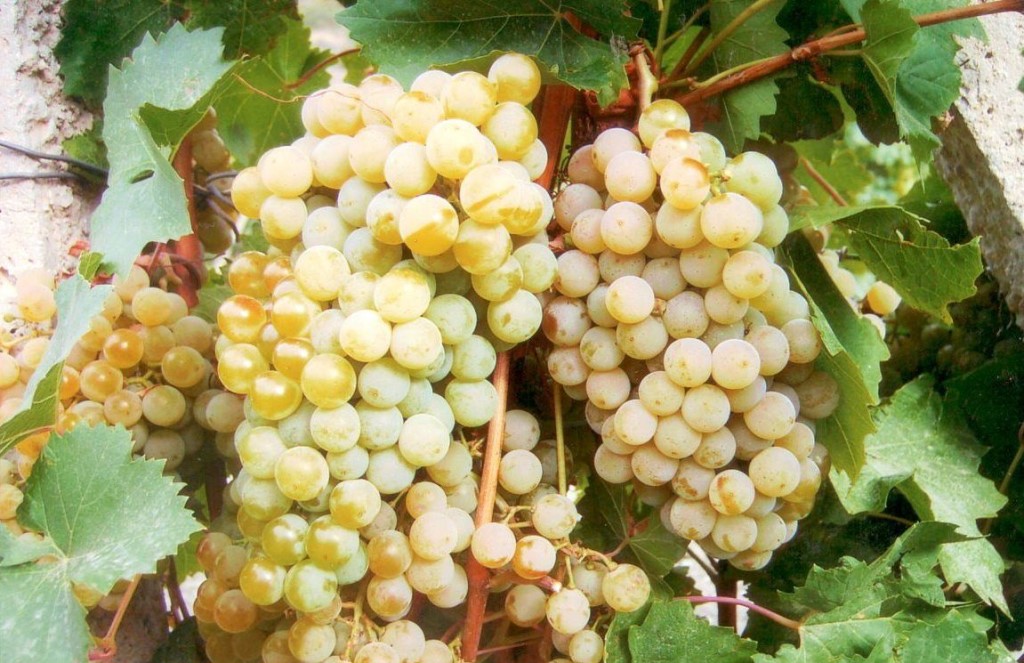
Crimean technical grape varieties have many varieties. Among them, Citron Magaracha is especially distinguished, beloved by winegrowers for their stable productivity and unpretentiousness.
From the berries get excellent table and dessert wine, with an original taste and aroma. Mostly the cultivar is cultivated in the southern regions, but middle-gardeners also successfully grow Magaracha.
Content
Grade description
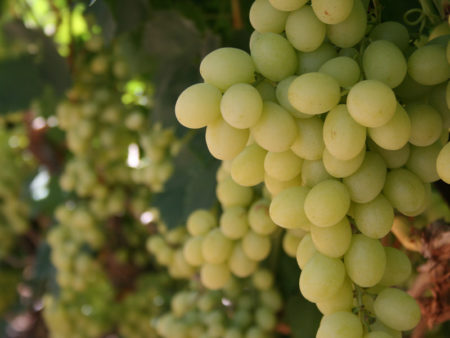
Citron was developed by scientists of the Magarach Research Institute (Crimea); it has been registered in the register of varieties since 2004. Recommended for use in winemaking (technical processing).
Parent couple - early Madeleine Anzhevin and Novoukrainsky. In terms of berry harvesting, a mid-ripening variety was obtained, the main purpose is to prepare dessert and table wines, champagne.
The young vine is green, the ripened shoots acquire a brown and dark red color. The growth force is high, the bush grows quickly, so you must immediately take care of the trellises.
Three-bladed leaf blades, with a smooth surface, without pubescence. In the area of the pink petiole, an open and heavily cut notch. The color of the leaves is bright green. Bisexual flowers. Citron Magaracha does not need replanting pollinators.
Fruit Description
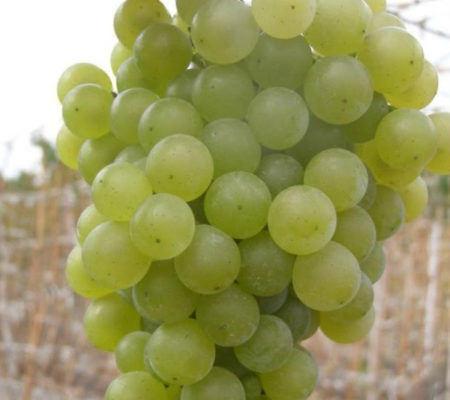
The clusters are elongated, conical in shape. The length reaches 18-22 cm. Usually several wings are formed. The standard weight is 250-270 grams, some copies grow to 320-350 grams.
Rounded berries with a thin, but strong skin. The color is golden, when ripe - yellow amber. 3-4 seeds are formed in dense pulp. By weight of the berries - 3-4 grams, sugar content - 25-27%. Acid - 6-7 g / l.
The taste is pleasant, with a pronounced aroma of citrus and nutmeg.
Vine ripening is stable, according to indicators - 85-90%. During the harvest period, 8-9 kg of berries are removed from an adult bush.
The variety is unpretentious, resistant to traditional diseases, is little affected by pests and is not attacked by wasps. It tolerates frosts down to -25ºC, but is most often grown as a cover crop.
The wine prepared from Magarachi has an exquisite floral-citrus aroma, the taste has a muscat shade.
The standard sugar content is gained by grapes cultivated in the Crimea. In other regions, sugar levels are lower. In the middle zone, Citron Magaracha is grown for blending with other grape varieties, in the south it is used as a mono variety.
Wines from berries are marked on a tasting scale as 7.8-7.9 points out of a total of 8 points. Citron Magaracha - the basis of wine brands awarded prizes at international exhibitions. One of the famous brands: Muskatel Bely (1998), who won awards at numerous competitions of winemakers from different countries.
Advantages and disadvantages
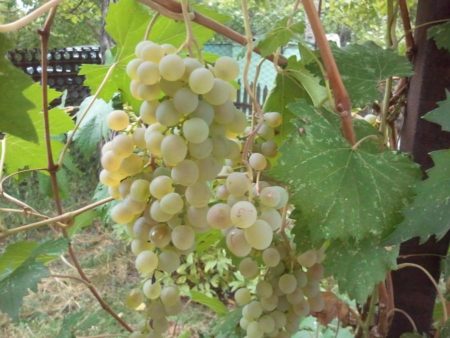
Judging by the reviews of winegrowers, Citron Magaracha is popular as a technical variety. It is appreciated for its unpretentiousness, stability, and resistance to disease.
Benefits:
- good taste;
- excellent raw materials for winemaking;
- high rates of maturation of shoots of the first year;
- dense structure of berries, lack of cracking;
- easy care.
Grapes - a culture that requires compliance with agricultural technology. But this variety is quite unpretentious, caring for it is standard, taking into account the characteristics of the terrain and weather.
Of the shortcomings, average frost resistance is noted, since, despite the declared characteristics, it is still required to cover the vine for wintering. Particularly attentive should be gardeners of the middle strip, the North-West, since in these territories Citron fruiting, but it requires more attention.
"Minuses":
- pi a large load is a delay in ripening berries in the brush;
- the need to ration grapes on the vine.
In comparison with the “pluses” there are not so many shortcomings.
Seat selection and landing
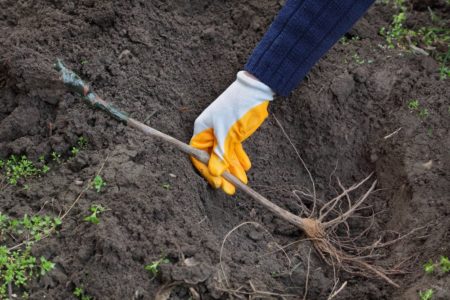
The heat-loving "southerner" prefers sunny, well-lit and sheltered from the winds places. It is advisable to buy seedlings in nurseries, with mandatory certificates. It is preferable to take plants with a closed root system.
The best soil near Magarachu is sandstone, with neutral acidity. On loams add ash, a little peat, humus. Acidic soils are ennobled by the addition of lime fluff or dolomite flour.
When planted in autumn, pits are prepared in 2-3 weeks; for spring planting, pits are dug in September or October. They bring a nutritious soil mixture (humus, ash, any complex fertilizer).
When planting, it is allowed to deepen the root neck to five centimeters. After planting, the seedlings are mulched with hay, peat or humus. The distance between the pits for Magarachi is 1.8-2 meters.
Agricultural technology
Compliance with simple techniques ensures good vine growth in the early years, the formation of fruiting shoots.
Watering and feeding
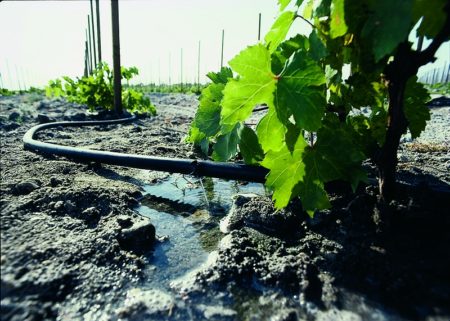
Variety Citron Magaracha is demanding on watering. It is especially important to observe the schedule in the first year of planting, when the roots of the seedling do not extend beyond the boundaries of the planting pit.
Irrigate plants every 7-10 days, focusing on the weather. It is advisable to water in the evening, using water warmed in the sun. The second year it will be enough to water once every 10-14 days, stopping watering by the time the vines ripen.
Approximate scheme:
- spring watering when buds open;
- after flowering, with the formation of berries;
- the beginning of ripening berries.
During the period when the grapes are in bloom, as well as at the peak of ripening, the plants are not watered. It is imperative to moisten the soil well, not limited to surface irrigation.
In the first two years, grapes do not need additional nutrition. The plant lacks fertilizers laid in the mixture in the planting pit. Starting from the third year, the vineyards feed, given the condition of the plants themselves.
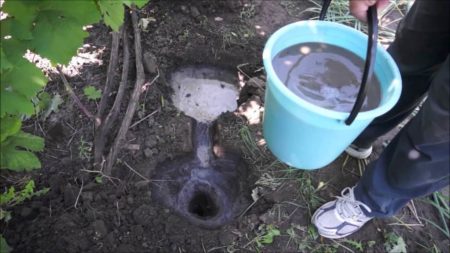
Scheme:
- Spring dressing, before flowering bushes. They bring organic matter (manure, wood ash). Under the bush, 10-20 liters of diluted mullein (1:10) is enough.
- Top dressing after flowering, about 10-12 days before the formation of the ovaries. Use active nitrogen (ammonium nitrate - 20 grams), calimag (10 grams). Fertilizers are bred in water, watered under the root.
- The third time they feed Magarach three weeks before the harvest. Exclude nitrogen from fertilizing, apply potassium and phosphorus. Best option: 20 grams of potassium fertilizer and the same amount of superphosphate. Such additives contribute to improving the taste of grapes, increasing the mass of berries.
- Autumn dressing is not carried out every year. If the vineyard is broken on fertile soils, then fertilize the plants in a year. Use complex mineral fertilizers.
Foliar top dressing of Magarachi Citron provides fast assimilation of nutrients. Options:
- processing leaves before flowering grapes, boric acid (5 grams per bucket of water);
- spraying after flowering (superphosphate extract);
- two weeks before picking berries (potash or phosphorus supplements).
Process the leaves on the underside.
Grape formation
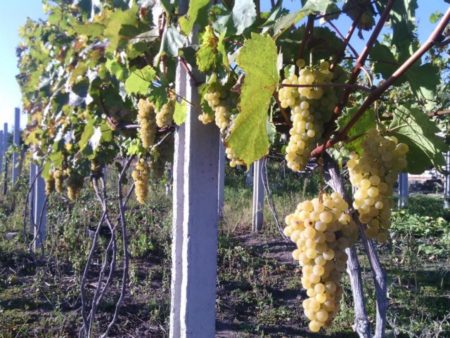
Magaracha Citron is prone to overload, therefore, in addition to the traditional formation of bushes and pruning, rationing of the vine is practiced.
Pruning of the vine goes to 8-10 kidneys. Form according to the scheme of a sleeve fan (usually 4 sleeves are left). In the absence of rationing, the vine will ripen later, while the mass of the hands and berries will decrease.
In the first year, leave no more than two strong shoots, the rest break out. Autumn minted bushes, stepsons removed. Cut shoots for 2-3 eyes, no more. In the second year, 3-5 strong shoots will appear, from which the four strongest are selected.
They should be long, strong. Each is shortened by 4 eyes, making sure that the branches do not go beyond the trellis. In the third year, there will be young twigs (vines) on the 4-sleeves, where it is quite possible that the first “signaling” (brush) of Magarachi will appear.
Trimming of the third year: selection along the branches of strong shoots (2 copies), removal of weak ones. It is advisable to leave a knot of substitution (pruning one shoot for 2 eyes).
After this, every year in the fall, a prolific vine is cut, a new one is cut, and the lower one is left for replacement.
Magarach is recommended to grow on a trellis with two planes.
Autumn pruning of adult bushes:
- removal of old, diseased branches;
- removal of weak shoots, last year’s vines,
After about 6-8 years, the vine bushes are rejuvenated, gradually replacing the obsolete sleeves with young branches.
Disease Prevention, Pest Control
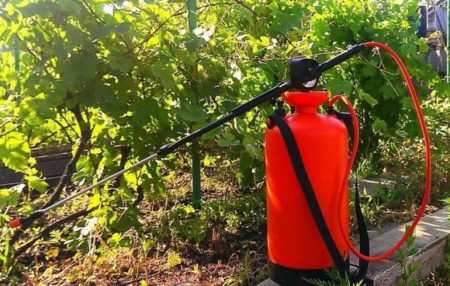
Citron Magaracha grapes are appreciated for their relatively high resistance to infection. With proper care, the variety is almost not affected by mildew, the root phylloxera.
Less resistance to oidium, but during the prevention and this adversity can be successfully avoided.
Preventive measures:
- spring treatment of bushes with Nitrafen (protective measures are mandatory when working);
- before flowering - treatment with any fungicides;
- for prophylaxis against oidium in July, Magarachu is sprayed with means of Quadris, Flint;
- in September, after harvesting, vineyards are sprayed with solutions of Strobi, Flint.
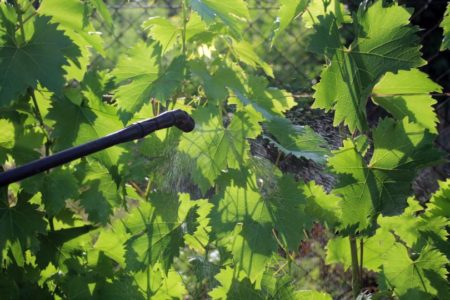
If signs of diseases and pests are not observed, spring preventive spraying is sufficient. For this, Bordeaux liquid, colloidal sulfur, copper chloride are suitable.
Indicators of resistance of Citron Magarachi to diseases:
- oidium - up to 2 points;
- mildew - up to 3 points.
Chemicals for preventive spraying can be replaced with folk remedies (onion peel, baking soda, tincture of horsetail, garlic).
Harvesting
The ripening time of the variety varies, as it depends on the weather, growing conditions. In Crimea, berries ripen in late August, in other regions with more severe conditions - in September.
Experienced growers keep the berries on the bush until they reach their maximum sugar content - 24-25%. At this moment, the grape acquires its inherent original musky taste.
With overexposure or, conversely, early collection, only citrus notes remain, no nutmeg. Therefore, for the preparation of wine it is very important to withstand time and not miss the moment of collection.
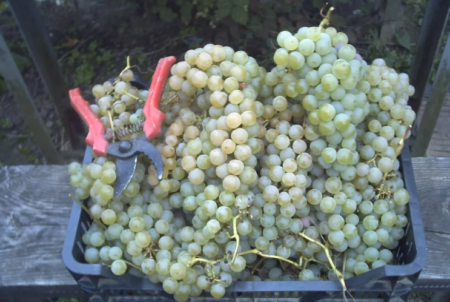
On an industrial scale, dessert and table wines with floral-citron and honey aromas are obtained from the variety's berries.
Grape variety Citron Magaracha - popular among gardeners in different regions. Despite the fact that it is recommended for the southern regions, industrial grapes are successfully grown in the more northern territories, getting excellent yields.
Reviews
Igor, Pavlovsky Posad
Citron Magaracha has been growing on the site since 2010. Great grapes, never let me down. In the first three years I do not leave brushes, even in the second year I remove the signaling. I leave on the third half of the brush. This gives a good root system formation.The berries are delicious, I make homemade wine, even factory wines have no such taste. All the relatives have the honor of citron wine.
Mikhail, Voronezh
I always praise Magarach, as the variety pleases with the harvest, the taste of berries. Really doesn't like overload. If you are too lazy and do not normalize, then in our area the vine does not ripen. But even if it ripens, then the nutmeg is laid slowly, you can’t get the desired taste of true Magarachi. The load is given only for 4 years, I leave the signaling in two pieces. The grapes themselves are delicious, refreshing.
Irina, Moscow Region
My Citron ripens late. Therefore, I take off the berries in our changing weather ahead of schedule, the taste is so-so, but this is understandable, not ripe. Perhaps I will refuse this variety; it is easier to bring grapes from the south to wine. I will continue to grow other varieties, earlier.




 Non-covering winter-hardy grape varieties for Moscow region
Non-covering winter-hardy grape varieties for Moscow region How to keep the vine in winter
How to keep the vine in winter When can I transfer grapes to another place in the fall
When can I transfer grapes to another place in the fall How to cover and prepare grapes for the winter in the suburbs
How to cover and prepare grapes for the winter in the suburbs